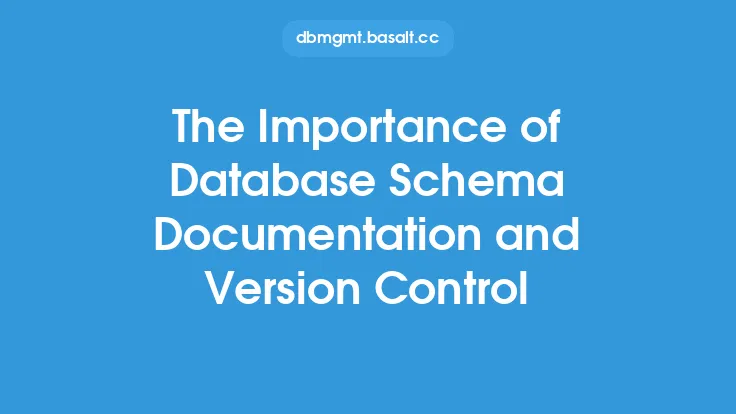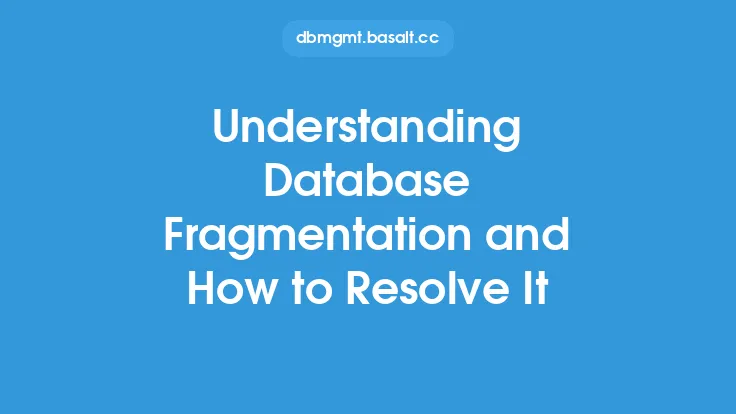Database schema documentation is a crucial aspect of database implementation that is often overlooked. It involves creating and maintaining detailed records of the database structure, including the relationships between different tables, columns, and data types. This documentation serves as a blueprint for the database, making it easier for developers, administrators, and users to understand and work with the database.
Introduction to Database Schema Documentation
Database schema documentation is essential for several reasons. Firstly, it helps to ensure data consistency and integrity by providing a clear understanding of the database structure and the relationships between different data entities. This, in turn, helps to prevent data errors and inconsistencies that can arise from a lack of understanding of the database schema. Secondly, database schema documentation facilitates communication among team members and stakeholders by providing a common language and framework for discussing database-related issues. Finally, it enables easier maintenance and updates of the database by providing a clear understanding of the database structure and the impact of changes on the overall system.
Benefits of Database Schema Documentation
The benefits of database schema documentation are numerous. Some of the most significant advantages include improved data quality, reduced errors, and increased productivity. By having a clear understanding of the database structure, developers and administrators can identify and fix errors more quickly, reducing downtime and improving overall system performance. Additionally, database schema documentation helps to ensure compliance with regulatory requirements and industry standards, reducing the risk of non-compliance and associated penalties. Furthermore, it facilitates knowledge sharing and transfer among team members, reducing the risk of knowledge loss and improving overall team efficiency.
Types of Database Schema Documentation
There are several types of database schema documentation, each serving a specific purpose. The most common types include entity-relationship diagrams (ERDs), data dictionaries, and database design documents. ERDs provide a visual representation of the database structure, showing the relationships between different tables and entities. Data dictionaries, on the other hand, provide detailed information about each column and table in the database, including data types, lengths, and descriptions. Database design documents provide a comprehensive overview of the database design, including the rationale behind design decisions and the overall architecture of the system.
Tools and Techniques for Database Schema Documentation
There are several tools and techniques available for creating and maintaining database schema documentation. Some of the most popular tools include database design software, such as Entity Framework and DBDesigner, and documentation tools, such as Doxygen and JavaDoc. Additionally, there are several techniques that can be used to create and maintain database schema documentation, including data modeling, database reverse engineering, and documentation generation. Data modeling involves creating a conceptual representation of the database structure, using techniques such as entity-relationship modeling and object-relational mapping. Database reverse engineering involves creating a database schema from an existing database, using tools such as database schema extractors and data dictionaries. Documentation generation involves automatically generating documentation from the database schema, using tools such as documentation generators and report writers.
Best Practices for Database Schema Documentation
There are several best practices that can be followed to ensure effective database schema documentation. Firstly, it is essential to create documentation that is accurate, complete, and up-to-date. This involves regularly reviewing and updating the documentation to reflect changes to the database schema. Secondly, it is essential to use standardized terminology and notation, to ensure consistency and clarity. Thirdly, it is essential to use visual aids, such as diagrams and charts, to help illustrate complex concepts and relationships. Finally, it is essential to make the documentation easily accessible and searchable, using tools such as documentation management systems and search engines.
Challenges and Limitations of Database Schema Documentation
Despite the importance of database schema documentation, there are several challenges and limitations that can make it difficult to create and maintain effective documentation. One of the most significant challenges is the complexity of the database schema, which can make it difficult to create accurate and comprehensive documentation. Additionally, the rapid pace of change in the database schema can make it challenging to keep the documentation up-to-date. Furthermore, the lack of standardization in database schema documentation can make it difficult to compare and contrast different databases and systems. Finally, the cost and resource requirements of creating and maintaining database schema documentation can be significant, making it challenging for organizations with limited resources.
Future of Database Schema Documentation
The future of database schema documentation is likely to be shaped by several trends and technologies, including cloud computing, big data, and artificial intelligence. Cloud computing is likely to increase the demand for database schema documentation, as more organizations move their databases to the cloud and require documentation to manage and maintain their cloud-based systems. Big data is likely to increase the complexity of database schema documentation, as organizations require documentation to manage and analyze large volumes of structured and unstructured data. Artificial intelligence is likely to automate many aspects of database schema documentation, using techniques such as machine learning and natural language processing to generate documentation and identify errors and inconsistencies. Overall, the future of database schema documentation is likely to be characterized by increased complexity, increased demand, and increased use of automation and artificial intelligence.





